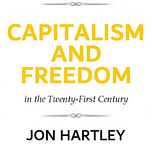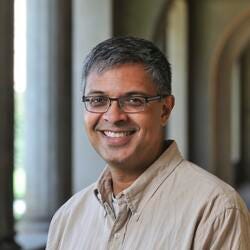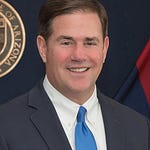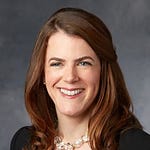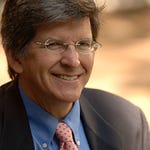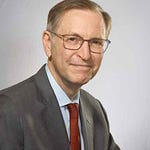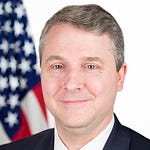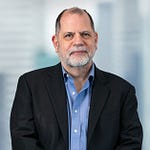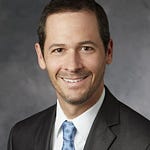Jay Bhattacharya (Stanford University Professor of Medicine) joins to the podcast to discuss his beginnings being born in Calcutta, India, his journey to Stanford as a student obtaining four degrees at the institution (BA, MD, MA, PhD) to becoming a Stanford professor along with his research, the COVID-19 pandemic, and his views on the inadequacies of the public health community and its handling of the pandemic policy response.
Jon: “This is the Capitalism and Freedom in the 21st Century podcast, where we talk about economics, markets, and public policy. I’m Jon Hartley, your host. Today, I am joined by Jay Bhattacharya, who is a professor of medicine at Stanford University and a research associate at the National Bureau of Economic Research. Jay has been one of the most thoughtful and prominent public health voices throughout the COVID-19 pandemic, and he's been one of the most critical of COVID-19 lockdowns and their knock-on effects on economic growth and livelihoods. Welcome, Jay.”
Jay: “Thank you for having me, John. Thank you for those kind words.”
Jon: “Jay, so you were, to start from the beginning, you were born in Calcutta, India. Tell us about how you came to the U.S., how you came to Stanford, and how you got into our undergrad program here, and you went to medical school here, got an M.D. here, you got an economics Ph.D. here, and you also became a professor here. You spent, I think, most of your life here. How did you become so fascinated with Stanford? How did you fall in love with Stanford, if it's fair enough to say? I don't know if you're still in love with it.”
Jay: “I once was in love with Stanford. I mean, I was born in Calcutta in 1968, well, near Calcutta, and my mom actually grew up in Calcutta, in a slum in Calcutta. My dad had a little more middle-class neighborhood. When my dad was a Ph.D. student, before he met my mom, he applied for the visa lottery, and when I was like three or four, he won the visa lottery.”
Jon: “This is the one that's like 1% every year?”
Jay: “Yeah, there were some quotas for different countries. I don't know. I don't know quite the details of it, but what I do know is that my dad came to the U.S. one year before. He was a Ph.D. in electrical engineering, couldn't find a job, so he worked at McDonald's for a year.”
Jon: “Wow.”
Jay: “Then me, my brother, and my mom came a year after, I think it was like 1972, or 1971, when I was very little. I grew up in Cambridge, Massachusetts, in the housing development. Until I was 11, my dad eventually got a job as an electrical engineer building jet engines for GE in Lynn, Massachusetts.”
Jon: “From McDonald's to jet engines.”
Jay: “Yeah, and then he got a job in General Dynamics, essentially as a rocket scientist in Southern California. I went to high school in Southern California. And then Stanford let me in. My parents told me I could only apply to in-state schools, and Stanford was an in-state school. I really liked math, and I liked sciences, and I was pretty good at them, so I don't know. It seemed like a natural place.”
Jon: “Wow, that's fantastic. And so, you got here as an undergrad. And at what point did you decide to become a health economist, go to medical school, and get an account at a pretty rare company?”
Jay: Yeah, well, I'm sure it's not the sanest thing to do. So, I came to Stanford as an undergrad in 1986, and I was really interested in chemistry, actually. I really liked it, and I thought I had it back on my head. What can I do with these sciences? I figured being a doctor would be a really good use of it. My dad had a heart attack before I came to Stanford, and I was really impressed by the ability of doctors to help in situations like that, like what my dad faced. I figured I wanted to use my knowledge or my capacities in math and sciences to become a doctor. That's all I really wanted. I arrived, and they used to have, or maybe I think they still have, these general ed requirements. And so, I just took econ because I wanted a whole general ed requirement. So, Professor Gavin Wright taught econ one. Yeah, so he's a great economic historian. I think he just retired. He's been retired for a little while from Stanford. Gavin Wright, yeah. And I just fell in love with it. I thought it was really, really interesting. The idea that you can use math and statistics for something other than chemistry and other sciences just blew me away. And then these were topics that were so obviously important to the health and well-being of huge numbers of people, vulnerable people. And so, I majored in econ. Another Stanford MD, PhD economist named Alan Garber, who's now the provost at Harvard, and did an honors thesis with him and just fell in love with economics, fell in love with the idea that you could use the methods of economics, the statistical methods, the basic idea of economics, which is that there's trade-offs for literally everything, and apply it to medicine. So obviously, clearly apply it to medicine. And so, yeah, that's how I started at Stanford as an undergrad. Finished undergrad with an econ major, but also pre-med. I finished the pre-med requirements, figuring that was going to be behind me. I'm done with economics. That was a fling. I'm going to go to medical school. Applied to medical schools. Actually, my dad died right around the end of my senior year. And I was going to go to medical school outside of California, but I wanted to be still in range of my mom. So, when Stanford let me in, I was thrilled.”
Jon: “Awesome. I mean, what a great feeling. And also, fantastic that you’re still here. So, you graduate, you're doing a Ph.D. in economics and an M.D. in medicine. It takes a little while. You graduate, you then enter a tenured track. Can you describe what, I guess, your research agenda was for, I guess, the past couple decades coming up to the COVID pandemic? I know the COVID pandemic obviously changed the trajectory of your career, but I'm curious, what were you doing before the COVID pandemic?”
Jay: “Yeah, so, in graduate school, eventually, medical school, I decided I needed a Ph.D. in economics. I couldn't let it go. And at some point, during grad school and medical school, I just, I mean, I just, every time I would do medicine, I'd feel like I was missing doing research. I didn't want to live my life thinking, you know, I'm doing something really important, like medical, you know, clinical medicine is very important in the life of people. And I didn't want to feel like I was only half-heartedly doing it, whereas I was wholeheartedly really interested in research. My thesis in economics was on physician labor markets, which was why do doctors earn, why do surgeons earn so much money relative to non-professionals? And my first job out of grad school was at RAND, the RAND Corporation, which is like a, for folks who don't know, it's a think tank in Southern California. The history of it is it's focused, it tends to be focused on defense industry things, but it actually became quite famous in health economics. It conducted this large, randomized experiment in the 70s of providing insurance to people, and the question was what effect did it have on domestic care? What effect did it have on health?”
Jon: “Does the RAND health insurance experiment is very famous. [Inaudible 8:20]
Jay: “Yeah, the RAND health insurance. And there were still people around from the RAND health insurance experiment days. It was just a vibrant place doing health economics. And one of the things that happens at RAND is you walk around and there are people with data and questions, and they're just looking for people to help on these projects. And I got involved very early on with a project on HIV, in particular on why it seemed like insurance coverage didn't seem to be improving the health of patients with HIV in the late 90s. It turned out really it had to do with the timing of when people got Medicaid because it was often too late. People who have HIV get sick, lose their jobs, not qualify for Medicaid for a long time, and then when they finally do qualify for Medicaid, it's too late because the Medicaid coverage didn't really help. So, the idea was that if you extended insurance coverage so they could afford medicines earlier, it would be, you know, you'd save a lot of HIV patients. Anyways, that project was really, really interesting. It got me interested in infectious disease epidemiology and infectious disease and health policy surrounding infectious disease epidemiology. An interest I've maintained throughout my entire career. So, I worked on – it's impossible at RAND to work on one issue. I worked on a very large number of issues. I got interested in the economics of obesity. In 2001, Alan Garber had started here at Stanford this center called the Center for Primary Care and Outcomes Research in the Medical School, and he opens up a search for new faculty. So, I've been at RAND for about three years, and when Alan called me, I mean, as you all have seen, your former advisors, and, you know, of course, coming back to Stanford was an absolute thrill.”
Jon: “Wow. Amazing, and I feel like Stanford benefits your support and to have you here for your career as well. You've also got, I think, a cross-appointment with virtually every possible institution I think you possibly could have transferred to. I don't know, but I'm sure that must be a record. Now, I want to sort of get into the COVID pandemic. How did the COVID pandemic change the trajectory of your career? And how has it changed sort of what you're focusing on now? Can you sort of get a little bit more into the Great Barrington Declaration? What does it mean? And how did that come about?”
Jay: “Well, in the early days of the pandemic, I had a couple of sort of twin inspirations. So first, I mean, I was born in a poor country. My mom grew up in a very, very poor part of Calcutta. I actually spent a little bit of time there when I was little in this Calcutta slum living, you know, in the summer with Michael in Calcutta, living in this slum called Kitterpool where my mom's parents lived and her sister and brother lived. So, I had the experience of seeing what poverty really means. And of course, in economics, you know, we spent the last 34 years being very proud of the fact that globalization has lifted almost 100 million, almost a billion people out of poverty, out of dire poverty. And the one thought I had was that, look, if we lock down, the West locks down, what will happen is that there will be these knock-on effects that will essentially reverse the gains from globalization in poor countries in the world. Now, globalization, what it actually means is that many poor countries reorganize their economies so that they fit in better with the world economy. That means many jobs – that was the engine that drove the uplifting of people out of poverty. People had jobs that were not previously available. By locking down the economy, we have a supply chain disruption. You're going to get a very large number of people at the very bottom of that supply chain losing their jobs and be at risk of dire poverty, at risk of starvation, can't feed their family. So that thought was very clear in my head when the lockdown was first imposed. The other thought was an epidemiological thought. The – in H1N1, during that H1N1 pandemic, the swine flu pandemic of 2009, the early estimates of mortality suggested that the World Health Organization suggested there was like a 3 or 4 or 5 percent mortality rate. What they were talking about was the case fatality rate. The numerator was all the people that had died from the swine flu, and the denominator was the set of people identified by public health and hospitals and so on to have had swine flu. The problem is that public health only has a limited visibility on the spread of the disease. There was a whole series of seroprevalence studies, seroprevalence meaning studies of prevalence in the blood, of antibodies to swine flu. And those seroprevalence studies in 2009 found that there were 100 or more infections out in the community of people who had the swine flu and recovered and had antibodies that had never come to the attention of public health because the disease was so mild for them. Swine flu did kill some people, and it was a severe disease for some people, but for most of the population it was a mild disease. And in fact, that literature found that the infection fatality rate wasn't 3 or 4 percent, it was more like .01 percent, 99.99 percent survival. That made it so that the initial panic of swine flu subsided very rapidly as that information came out. And so, the second thought I had on COVID in the early days was, well, this is a very highly infectious disease. We don't know how far and wide it's spread. What we need is a study to measure that spread of the disease, just like we've done with Swine Flu.”
Jon: “Got it. And so, I guess I want one question. I know early in the pandemic there was this question about, was it NPIs, like lockdowns, non-pharmaceutical interventions, that were causing or that would cause losses in economic activity or GDP or output? Or was it the pandemic itself, that people are so scared, they don't want to go outside, they don't want to do business, and that regardless of whether you had NPIs or not, or lockdowns or not, you would have some shortfall in economic activity, regardless of what the governor and I think the others argued. Is it fair to say that you're pretty squarely in that other camp, that lockdowns, NPIs do cause significant losses in economic activity, which has these knock-on effects of lower welfare as a result of the disease?”
Jay: “Yeah, so it's complicated. So, first of all, I do think that lockdowns had a tremendously bad negative economic effect. But the mechanisms, the idea that people lock themselves down anyway for fear is true. That is absolutely true. But it's important to understand the limitations of that idea. So, first, and this is really important to stress, the fear itself was a policy choice. The World Health Organization chose to send out the signal that three or four percent of people would die if they got infected. That was a policy choice to put out a very inaccurate mortality number, way too high relative to the truth. It was a policy choice by public health to spread the message that everyone was effectively equally at risk of COVID, even though it was clear from the Chinese data, from the Diamond Princess data, that it was really older people that were the highest risk group. There was a thousand-fold or more difference in the mortality risk of COVID infection from the oldest to the youngest. And that young people were actually relatively low risk, much lower risk than many other threats to their lives, for instance, not going to school. So that fear itself was endogenous. The second thing, and this is really important about the limitations of that argument, the set of people who could actually lock themselves away without risk to their health and well-being was very limited. Worldwide, maybe two percent of the population. In the United States, maybe 20 or 30 percent of the population. I call them the laptop class. The set of people who would not lose their job, not lose their livelihood, because they could replace the work that they were doing in person with work from home. Staying home, stay safe was an incredibly classist, elitist message. The vast majority of the world population could not advise by this. When you look at the mobility data from around the world around the initial lockdowns, it's very, very clear that it's only the richer neighborhoods that had low mobility, that extended past two weeks. The first two weeks after the initial scare in March 2020, you see decline in mobility for everybody. But very soon, the poor neighborhoods, you start to see upticks in cases, upticks in mobility, because poor people can't abide a lockdown. They can't afford to stay home and stay safe, because if they do, their children will starve. So, I think that there are very strong limits to that argument. I think the fact that people do have behavioral responses, The fact that people do have behavioral responses to perceived threats, that's a classic idea in epidemiology. It's an idea I've taught. It's an idea I've written papers on. For instance, it has consequences for vaccination demand. It's a classic idea. It's not new to me. But it was very badly misapplied by economists over the years.”
Jon: “You're one of the three signatories of the Great Variance Declaration. Can you explain what its original intent is? And maybe more importantly, just what your optimal policy approach or prescription is for dealing with COVID-19 and perhaps other pandemics in general?”
Jay: “So, the Great Variance Declaration, we're in October 2020 with Martin Kulldorff of Harvard. I'll leave at Harvard now. And then Sunetra Gupta of Oxford, two very fantastic epidemiologists. Sunetra is a theoretical epidemiologist, first order. At Oxford, she's designing a universal vaccine for the flu. That was the thing that she was doing immediately before the pandemic. Martin Kulldorff was a biostatistician who designed the statistical infrastructure used by the FDA and CDC to track vaccine safety. We come together in Great Barriers, Massachusetts in October 2020, basically because the lockdowns, which I explained to you why I was already skeptical about them, had already done tremendous damage. School closures had already harmed the lives of a tremendous number of children worldwide. And the effects of the lockdowns on the poor and the working class had already become manifest. The UN World Food Program was already issuing statements like, you know, 100 million people are going to starve as a consequence of the lockdown. And yet the world was ignoring it. And in October 2020, people were – the summer had come and the disease wasn't quite so panic-making as it had been in March of 2020. It looked like it was starting to go away to some people. It was really clear from the epidemiological data to me that the disease was coming back. There was some sense that the seroprevalence studies showed maybe 15, 20 percent of the population, depending on the country and place, in the U.S. I think it was 10, 10, 15 percent of the population had been infected. That meant there was a large fraction of the population that was still quite uninfected. So, the disease was very clearly coming back. It wasn't gone. Still a very highly infectious disease. In the summer, you've seen it spread, for instance, in over in Arizona, having all kinds of problems. And it was also clear that if it came back, the lockdown could come back. And with the lockdown, the same damage to the poor, the same damage to children, the same damage to the working class. So, we were able to make that declaration to propose a strategy that we call focus protection. The idea is very simple. We know that the highest risk people are people that are elderly. We know there are some conditions that can affect the risk as well. But the single most important risk factor for a bad outcome is your age. And roughly every seven years of age doubles your ineffectuality rate. According to the ineffectuality data. So, what we proposed was focus protection for older people and then lifting lockdowns. That is actually a completely unoriginal idea. It's the same strategy that has been followed basically in every single respiratory virus pandemic going back a century. In 2009, that's what we did. We did a lockdown. of society when there was a swine flu pandemic. What we did is we tried to develop as rapidly as possible vaccines and therapeutics and deploy them at scale for older people, for the people at the highest risk. And at the same time, disrupt the lives of everyone else as little as possible, as we did in the United States. Mexico actually locked down on it, and it caused tremendous damage. They decided it was a mistake in 2009. And if you go back a century, you see respiratory virus pandemic after respiratory virus pandemic, you see the same strategy, and it works. Don't panic society, because by panicking society, you harm the people who are going to need to afford it. And do work to protect vulnerable people as best you can, given the technologies we have. And we were calling for a conversation by people in public health, local public health, is that the exact kind of what focus protection actually means is a very local thing, in terms of local living circumstances. And it was a one-page document. We were calling for change in strategy. But in that, we also included a lot of suggestions for exactly what focus protection could look like. For instance, giving leave to people who are older, sabbatical leave, when the disease is spreading rapidly. So, all kinds of ideas we included in the website that we wrote for how to do focus protection.”
Jon: “I'm curious, in terms of school shutdowns, I think there's sort of an interesting example where there was a pretty rapid change in so-called consensus around whether or not schools should be reopened and the potential damage that could have in terms of educational outcomes. I'm curious if you thought about that whole episode and how it played out in, I guess, the intellectual public health establishment and how that changed so quickly. I'm curious what your thinking has been around. You and others have been dismissed by folks at the NIH, by folks, certainly, I think, on YouTube and elsewhere. And here at Stanford, I'm curious, what has that whole experience been like? I don't think you've ever in your entire career been seen or viewed in any way as being a partisan figure. You're still, in my opinion, not a partisan figure at all. I'm just curious, how has this saga changed your thinking around, really, do we value truth? Is truth at all really a value, or is it more so about promoting early hypotheses that people tend to cling to? Science, ultimately, is about postulating hypotheses and ultimately ruling out incorrect hypotheses. I'm just curious, how is your view of how science has been done in these great institutions? How has that changed? And what has this experience been like for such incredible scholars such as yourselves?”
Jay: “So why don't we start with the schools, because that's a good way to get into the rest of the question. In August of 2020, it was really clear to me that one of the worst mistakes we'd made in the spring was closing schools. There was data out of Iceland that suggested that kids were not super spreaders. They could spread the disease, but they were not super spreaders like they might be with some of the other respiratory viruses. And so, they didn't pose any special extra risk. Sweden had kept its schools for kids 15 and under open the entire pandemic with no restrictions, no social distancing, nothing, just normal schools, even in the spring of 2020. And there were reports that had come out of that experience that not only did no children die in that spring from COVID, but also that the teachers themselves were relatively lower risk of getting COVID and dying than the rest of the population. Being around kids had actually protected them against COVID. There were some arguments for why that might be the case. For instance, if you were like parents with young kids, actually. compared to age-matched other adults, did better on COVID-19, maybe because they were exposed to other coronaviruses that had some measure of protection against COVID, which is also a coronavirus. I mean, there's some theories around that. There's some data around that to suggest that that was true. In any case, the point is that there was not a special risk to teachers, and kids themselves are very, very low risk. And so, on the basis of that evidence, Europe opened its schools. And the governor of Florida decided to open schools in Florida. He sent an email out. He sent an order out, executive order out, saying that every school in Florida had to provide an in-person option. And what happened next was that the Florida teachers' union sued the governor to close the schools. And the folks in Florida couldn't find an expert to defend the governor's decision in court. So, when they contacted me, I jumped at the chance to get on this, because I knew what the literature had said. And we eventually won. But there were experts on the other side who were just – I mean, they just didn't understand the data. It was really clear they didn't understand the data, and it was also clear they were very scared by COVID. And yet, there were prominent institutions on the other side arguing that kids should have their schools closed in Florida. A lot of what happened during the pandemic revealed big gaps in the ability of people in prominent institutions, including in Stanford, to read the data appropriately and react appropriately. A lot of what happened was decision-making out of fear and panic, and inability to understand that there could be other views, to seek to learn from other views. There was no – on Stanford campus, for instance, there was no debate ever set up between me and other people who disagreed with me regarding the safety of school closures, for instance. There was a JAMA pediatrics paper in 2020 that found that just the spring closures had led – that will lead to almost 5.5 million life years lost for American kids. And this is just a classic result in the literature, in the health economics literature, that if you have – that school was an incredibly good investment in health. You increase school – if you increase the amount of time people – kids stay in school for just a short while, it actually has long-term positive consequences. They lead to healthier, longer lives as a consequence of more complete school. That was a well-established finding in the literature. Health economists, for the most part, stayed silent about that finding, which still shocks me. What should have happened was debates. That's how – it's not bad or wrong for scientists to be wrong about something. It's just normal. What was bad was that it was seen as so far outside the bound to say that kids should go to school in August of 2020 in the United States that a place like Stanford University wouldn't even host a debate about it.”
Jon: “And so, pivoting toward sort of the scientific establishment, I'm curious, like, personally, like, how have you experienced this whole – like, what does it feel like to have – you're such a decorated scientist. What does it feel like to have, you know, peers, people who you've held in highest esteem for, I'm sure, your entire career, sort of have this about terms that seems to be not sort of true to the scientific method, and, you know, like, well, you must be wrong, even though maybe they don't have, you know, all the evidence or they're sticking to, you know, certain studies or certain sort of pre-drawn narratives. I'm curious, like, what is that personal experience like?”
Jay: “I felt like excommunication. I mean, it was – it was through the summer of 2020, and especially the spring of 2020, almost from the first moment, I started speaking out publicly about my ideas about the pandemic. I've received death threats. I've received, like, racist attacks. But on Stanford campus, it felt like – so A hundred of my colleagues signed a letter attacking Scott Atlas for the crime of being President Trump's COVID advisor on ridiculous grounds. The letter attacking him hinted at the idea that he was opposed to handwashing, which was not true. It was ridiculous. They never even approached him and asked him what his ideas actually were. And Scott and I got to know each other, actually during the pandemic. We were exchanging papers with each other, just talking to each other all the time. He knew a lot more about the pandemic than those hundred people who signed that letter against him. And it essentially created this atmosphere, this hostile work environment at Stanford, where people who didn't agree with the lockdowns felt like they didn't belong on campus. Every single person I know who had reservations about lockdowns on campus felt the same exact way. And it felt not anything like the Stanford that I fell in love with in 1986. I kept thinking the motto of the university is, you know, let the winds of freedom blow in Germany. But the winds of freedom did not blow at Stanford during the pandemic. In fact, it was a very stifling environment designed to create a false sense of unanimity around a lockdown policy that did not exist either on campus and, of course, not in the broader scientific community.”
Jon: “I'm curious, I want to shift a little bit toward vaccines. And I'm curious, like, one, it seems so interesting to me how, you know, starkly different the public health element of sort of COVID response, the issue of lockdown and so forth, how different it's really been from the biotechnology side of things, which is, you know, just how quickly, you know, we're able to develop a vaccine that I think exceeds many expectations. And it's like, when you think about, one, the sort of race to develop vaccine, about things like Operation Warp Speed, advanced market experiments for vaccines, do you think that that's like a huge success story? And I'm just curious, like, do you think that maybe it's somewhat underappreciated because, you know, President Trump that was, you know, in office while this was where it started? I think, you know, President Biden is taking care of this too, and probably deserves some credit too. But I'm curious, when you think about that, and I'm also curious, like, what you think about the, since then, you know, there's been this huge movement that is opposed to vaccines, and there's many people that have advocated, you know, very strongly for vaccine mandates, whether it's governments or private sector bodies that should be implementing these things. I'm curious, like, what are your views on sort of this moment of the pandemic sort of since the vaccine sort of started coming online in 2021?”
Jay: “So, the first part of the question, what do I think of Operation Warp Speed? I should say that it's, like, as a full confession, one of the things I got the most wrong during the pandemic is that in February, March 2020, I thought it was not possible to develop a vaccine within months. I thought it would take years. And the reason for that was that we didn't have a coronavirus vaccine. And there was a history going back to, you know, at least two decades of attempts that didn't seem to mean we're going anywhere. So, I didn't see how it would be possible to develop a vaccine so rapidly. And so, when President Trump ordered Operation Warp Speed, I was very skeptical whether it would succeed. Then, as the season wore on, it became clear to me that this actually potentially might work. In any case, there's, of course, there's no uncertainty around that, let's say, in July 2020, whether it will work. The government makes an advanced commitment, says, look, we're going to buy your vaccine, whether it works or not, in order to provide some incentive to do this rapid development, right, change what all your research is doing to focus on this, very expensive for a drug company. I actually thought that was a really good idea. And the reason is the asymmetric loss, okay, if the vaccine doesn't work, then, okay, yeah, you lose a billion dollars, what's the big deal? But if it does work, you've done something really amazing, right, potentially save the lives of a tremendous number of people. And so, I was actually, I was okay with that policy, even as I thought it's unlikely to work. And then, when the vaccine actually, the trial came out, it actually worked, I was over the moon. I was absolutely thrilled. To me, it still is a triumph of science. Now, there's some ambiguity around this, like, how is it that we had a spike protein target for the vaccine so quickly? Normally, it would take a long time. A lot of that is actually based on a research program of finding viruses that are potentially pathogenic in the environment, and then augmenting them and doing vaccine research with them early, so that when there's a pandemic, you have a lot of knowledge. So, what if that research itself was the cause of the pandemic? All right, so that's, there's some, certainly some ambiguity about how this technological advance came about. But the fact that the vaccine did come about, I think, was an amazing thing to me in December 2020. Now, it's one thing to develop the technology of this mRNA platform or the adenovirus platforms for the vaccines, or even the traditional vaccine platforms. That's one thing. It's another thing for how do you assess clinically whether it's worthwhile or not, or will it work or not. The trials themselves were these huge trials, like 40,000 people, I think, in the Pfizer or something on that order. And it was the fact that it could be run so quickly was an amazing thing to me. So first, if it's run quickly, that means you will only know about what the effects are of the vaccine for the duration of the trial, right? So, in this case, like two or three months. So, you don't know any long-term effects of the vaccine from the trial itself in December 2020. There's no two or three months of data. The trial had as an endpoint the prevention of symptomatic infection. That is actually not that important from an epidemiological point of view. From an epidemiological point of view, there's two other outcomes that are more important. One is prevention of all infection and prevention of transmission of the disease. That's an endpoint that you could look at that the trials didn't look at. Symptomatic infection, 95% effective. But that doesn't mean that it's 95% effective against all infection. And it certainly doesn't mean that it's going to be long-lasting protection. You only known for two or three months. The other clinical endpoint you could have looked at that didn't was prevention of death or prevention of hospitalization. That would have required a much, much larger trial. But that also has a really important epidemiological consequence. So, the reason why those are two really important epidemiological endpoints is because if you just have knowledge that you prevented severe disease and death, then what you do is you just use the vaccine for focus protection. Give it to people who are at highest risk, reduce their risk of death, roll it out rapidly for those groups first, and then make it optional for the rest. It's not nearly as important for people who have a very low risk of infection from dying from the disease. But you can make it available, but it's not like the highest epidemiological priority. If on the other hand, you have prevention of transmission, well, then what you need is a very large fraction of the population to get vaccinated. And then the disease will just die out to low levels because such a large fraction of the population is vaccinated. The problem was that we didn't know it would prevent transmission with certainty. We didn't know with certainty it would prevent hospitalizations and deaths in December 2020. The public health then had to make a guess, which was more likely than what was going to happen. Public health guessed wrong. I actually wrote an op-ed in December 2020 in the Wall Street Journal it's an intergroup argument that we should use the vaccine for focus protection of older people. And the reason was that if it prevents symptomatic infection, then very likely it also prevents severe disease. You don't get severe disease unless you've had some symptomatic infections for whatever reason. So, we were pretty certain that it would prevent severe disease from the randomized trials, at least for two or three months. And if we rapidly rolled out the vaccine to older people, there was a wave coming. We're in the middle of a wave of cases that could prevent a lot of deaths. That was the argument. I think that argument is still right. The other side, you know, Anthony Fauci and others pushed for 70, 80% of the population has to be vaccinated to meet the herd immunity threshold, but she didn't actually know what that number was. No one did. And that's what led to this tremendous push to vaccinate everybody, even at the cost of telling people falsehoods. After a couple of months of experience with the vaccine, it became very clear that the vaccine does not stop transmission, does not stop you from getting it. Heavily vaccinated countries in late spring 2021 started to see big outbreaks of cases. We knew from then that the vaccine could not be used for disease, suppressing disease down to zero. Nevertheless, we went on with these vaccine passports where we essentially discriminated against the unvaccinated people, treated them like pariahs, second-class citizens. Vaccine mandates where many people who didn't want the vaccine actually probably clinically was not particularly beneficial to them. They were low risk. They lost their jobs. A lot of people who have family abroad where the vaccines weren't even available yet, they couldn't have the family come visit because of this discriminatory policy where vaccinated visitors were not allowed in the United States. That's still in place today. And what it did is it created this sense that public health doesn't know what it's doing. It said that if you get the vaccine, you wouldn't get infected. Well, so many people got the vaccine and then were infected. That happened to me. I was fully vaccinated in April of 2021, and in August of 2021, I got COVID. So, it's one of these things where public health will blame misinformation, but they should point the finger at themselves. They were the main source of this misinformation. Long after it became clear in the scientific data that the vaccine didn't stop transmission, they kept insisting that it would, that it was vitally important. And it is no wonder that people have lost trust in public health when they were so wrong, so adamantly wrong, and then they tied that to policies that damaged the lives of people, disrupted their lives. People started treating unvaccinated people like pariahs. You know, Thanksgiving of 2021, I kept getting emails from people who are very unhappy because their families uninvited them from Thanksgiving because they weren't vaccinated. I mean, that is a consequence of public health misinformation. It's a campaign that has resulted in widespread, a much, much broader, a much broader anti-vaccine movement that has ever existed that I've seen in my career. And it is directly the consequence of public health not understanding the science, not understanding the limits of basic civil liberties, and not understanding its vital role in making sure that it doesn't create social division, and it failed on all those bases.”
Jon: “And sort of just one last question here. So, I mean, one, like going forward in terms of preventing pandemics, addressing pandemics when they occur, it seems like one pattern that sort of emerged is that, you know, these things like, you know, operational or advanced market commitments do seem to be, you know, useful mechanisms now to build up capacity for vaccines. These are things that we didn't have before, you know, when we can sort of have, you know, sort of incentives aligned to make, you know, effectively billions of vaccines in, you know, the shortest possible period of time. And then perhaps, I know it's been done before for, you know, for pneumoco and I think potentially in the future maybe for malaria. I'm curious, like, looking back on all of this, this entire experience, what do you hope we will learn as a community, both scientific and non-scientific as well, for public health, biotechnology and so forth? What do you think we should have learned from this pandemic? And what should we be doing to prepare or get ready for the next pandemic when it comes?”
Jay: “I think that the primary lesson for public health in this pandemic should be humility. Public health did everything, almost everything wrong. And as a result, public trust in public health is at its lowest point I've ever seen in my career. And it needs to ask itself why all of this went wrong. The answer is not going to be other people. It will be public health officials; it will be academics in public health. It will be public health itself that is to blame. We violated the civil liberties of a tremendous number of people in lockdown. We harmed the lives and health of literally tens of millions of people with the policies that were pushed by public health, that were told by public health would solve the epidemic. And there really isn't introspection on the place of public health, honest introspection. And then tied to public health leaders who made these mistakes, losing their positions, I don't see how the public will ever trust public health again. As far as preparing for the next pandemic, I actually think the old plan worked pretty well. I'm okay with newfangled things like pre-commitments for vaccines and essentially contests to produce vaccines rapidly. I mean, that's fine. But as long as it's tied to, as long as that kind of effort isn't tied to really, really bad policies. So just keep that in mind. Imagine another pandemic starts and some president says, look, we're going to do an Operation Warp 10 speed, and we'll have a vaccine in three months. Well, the push to lockdown will be tremendous given the structure of public health we have now. But three months of lockdown is not a trivial thing. It means that a very large number of people around the world will starve. It means that our children, their schooling will be interrupted with consequences for health and well-being for the rest of their lives, that the working-class people will suffer. Tying lockdown policies to the potential for whether a vaccine may or may not work at warp speed is a tremendously bad policy. And so that's what I'm afraid is going to happen. It's okay, in fact, an active good to have this technological capacity. We don't know for certain it will work, but it's really good to have this. It's the kind of thing we ought to be able to do, we ought to be able to invest in. But public health has to draw a firm line and say we're never going to use this as an excuse to do tremendously stupid things like lockdown.”
Jon: “Wow, that's been such a fascinating conversation, Jay, and really just a real pleasure to hear your thoughts and you sort of summarizing your views on all of these issues. You know, I know you've been certainly one of the most prominent voices and commentators throughout the entire pandemic, and I salute you for contributing to such an important public service, and especially when lives and livelihoods are both on the line. Thank you so much for joining us, Jay. It's been a real pleasure. Thank you, Jon. Thank you for this conversation. It was fun. Today, our guest was Jay Bhattacharya, who's a professor of medicine at Sanford University and is a research associate at the National Bureau of Economic Research. This is the Capitalism and Freedom in the 21st Century podcast, where we talk about economics, markets, and public policy. I'm Jon Hartley, your host. Thanks so much for joining us.


